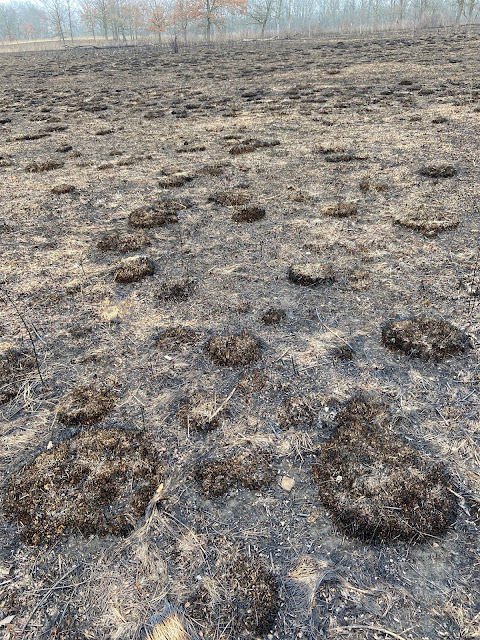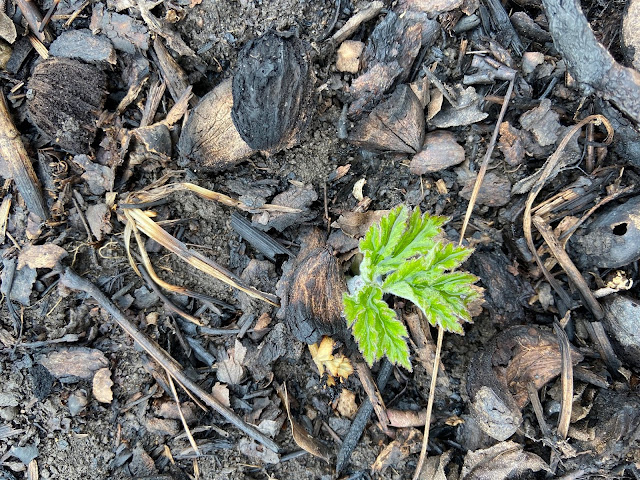Even more graphic, "spring" in the open grassland:
Those clumps represent thriving Dropseed and Little Bluestem plants, but today the thriving is in their roots. They're getting ready.
As with this deer pelvis, the spirit of the moment may seem death and drear.
Yet, on south-facing slopes, there is assurance of the life to come. Here we have the first harbinger of grassland spring at Somme - the temporary purple of Prairie Betony leaves, starting to emerge and unfold.
Betony will soon be spreading green, fern-like leaves topped with yellow flower clusters. Those sprigs of green today are nodding onion that will bloom mid-summer. It's all starting.
One hundred years ago, in 1920, E. S. Millay rather insulted Spring in a "cynical" poem. We’ll get to her later in this post. I invoke Ms. Millay here at the start because now, Spring 2020, angst roams the land. A pandemic threatens. Can spring help us?
In the woodland, the spring flora races to complete its version of 2020 before tree leaves block too much light. The green above is False Mermaid - an uncommon, conservative annual. Soon it will sprawl like mermaid hair. It will flower, set seed, and be gone before many prairie plants have even emerged from the ground. It's a part of the wow of diversity.
Most of the burned woodland still looks like this. Soon to be a riot of color, bird-song, and butterfly flutters, it's now soaking up sun, warming, getting ready.
Of course, much of the woods wasn't burned this year. Above, a stream was the firebreak used to protect some of this habitat. Some animals will survive better with unburned cover - though truth to tell, they'll migrate quickly to the burned area once the vegetation emerges.
The plants of the burned area will emerge much earlier, as sun warms the black soil. The burned areas will have taller grasses and more abundant wildflowers. Oak woods and prairies thrive on fire.
Yet fire is a harsh force. Here: the way of all flesh is mirrored by the way of all plants. Old and sick trees die and burn. They make way for the new.
We protected five of the young oaks shown here from fire by raking grass and leaves away from their little trunks. On the ancient natural landscape, young oaks burned off and re-sprouted with every fire. They developed bark thick enough to survive fire only when chance left them unburned for a few years. For decades, we waited for some of these young oak trunks to withstand the frequent fires. None did. They're burn and start over. So now, in some places, we rake around some trees, as nature seems to need that help, these days.
By the remains of a hickory nut, the green will soon be lush Chicago Leeks. Beautiful and delicious - but leave them alone at Somme. In some areas they've been badly depleted by poaching. The treasure of this ecosystem is protected by preserve status.
Closely related, these are the shoots of Wild Leek, very distinct in many ways from Chicago leek, at least to those of us who enjoy seeing as much of diversity as we can.
We don't see many animals yet. But a Prairie Crayfish clearly has been busy improving its burrow. Soon on rainy days we'll occasionally see the little lobsters walking toward ponds with their babies.
Does spring inspire you every year? It does me. Edna St.Vincent Millay resisted that inspiration in a poem:
Spring
To what purpose, April, do you return again?
Beauty is not enough.
You can no longer quiet me with the redness
Of little leaves opening stickily.
I know what I know.
The sun is hot on my neck as I observe
The spikes of the crocus.
The smell of the earth is good.
It is apparent that there is no death.
But what does that signify?
Not only under ground are the brains of men
Eaten by maggots.
Life in itself
Is nothing.
An empty cup, a flight of uncarpeted stairs.
It is not enough that yearly, down this hill,
April
Comes like an idiot, babbling and strewing flowers.
Why have I always liked that alienated poem? She's such a clear and keen observer. She inspires us to want more - and not to be lulled and satisfied by the superficial.
Possibly her most famous poem is short and equally impatient:
My candle burns at both ends;
It will not last the night;
But ah, my foes, and oh, my friends -
It gives a lovely light!
In these days, there seems to be little room for such idealistic impatience. But the Earth increasingly is fragile. We abuse it, complacently, at our peril.
So, perhaps we can have some modest hope for our culture's re-examination of purposes, priorities, and possible futures. Life can be good. The planet needs us.
Another poet, Bob Dylan, once ended a song about nuclear obliteration, “I’ll let you be in my dreams if I can be in yours.” Joining Bob’s hope with Edna’s impatience, that could be good.
Is change is in the wind?
 |
| This post-fire photo is not from Somme. But somehow it seemed right here. It shows four Somme volunteers who helped out last week on a desperately-needed burn at a cemetery prairie Nature Preserve in rural Grundy County: (from left to right) Eriko Kojima, Katie Kucera, Christos Economou, and Peter Kim. We felt happy about it. We are part of Friends of Illinois Nature Preserves and want to help. |
Acknowledgements
Thanks to Christos Economou for many helpful edits.
Thanks to Bob Dylan for the "Talking World War III Blues"
As Dylan talks it, he told a doctor that he'd dreamed that after the bombs, there was no one left but him. Bob ended his song this way:
Thanks to Christos Economou for many helpful edits.
Thanks to Bob Dylan for the "Talking World War III Blues"
Well, the doctor interrupted me just about then
Sayin, Hey I've been havin' the same old dreams.
But mine was a little different you see:
I dreamt that the only person left after the war was me.
I didn't see you around.
Well, now time passed and now it seems
Everybody's having them dreams.
Everybody sees themselves walkin' around with no one else.
Half of the people can be part right all of the time;
Some of the people can be all right part of the time;
But all of the people can't be all right all of the time.
I think Abraham Lincoln said that.
I'll let you be in my dreams if I can be in yours:
I said that.
In the barren cold of early spring, what are we dreaming of now?
We dream of May, June, and July.
To end this post, here's a photo of July - after such a burn. We know in our blood what's coming:














3 comments:
Thank you for the refreshing. From those in lockdown who have only visuals you provide. And words of renewal, reminders of promises kept .
Mother Earth is sneezing at our irritating her, but is showing how quickly she responds with renewed like. Thanks for the look in.
Bill hunt
Great burn! I realized I was looking at Floerkea last Sunday after seeing this post.
Larry
What a piece. I like that poem by Edna St. Vincent Millay.
Why do we fall for the con that Beauty is Truth?
Post a Comment